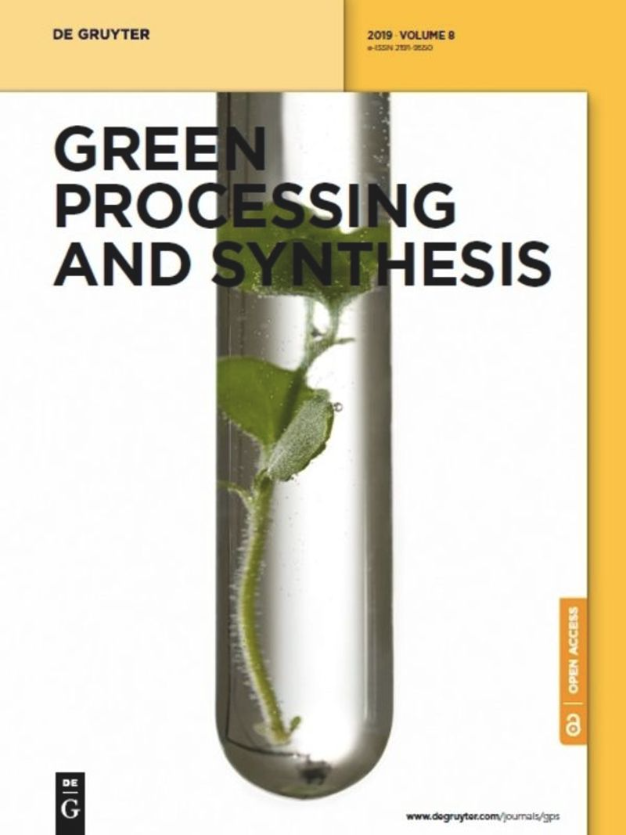Characterization of bio-oil production by microwave pyrolysis from cashew nut shells and Cassia fistula pods
IF 3
4区 工程技术
Q2 CHEMISTRY, MULTIDISCIPLINARY
引用次数: 0
Abstract
Abstract In this study, the production of bio-oil by pyrolysis with microwave (MW) heating was tested experimentally. Two magnetrons with a total MW power of 1,600 W were used in the pyrolysis setup. The electric field strength was 185.38 V·m−2 at an MW frequency of 2.45 GHz. Cashew nut shells (CNS) or Cassia fistula pods (CFP) were pyrolyzed at 400°C, 500°C, or 600°C, with biomass-to-activated carbon ratio set at 70:30, 80:20, or 90:10. The largest yield of bio-oil was found for CNS at 600°C, and for CFP at 500°C, both with 90:10 ratio, achieving, respectively, 20.0% and 15.8% yields. When the bio-oil yields from CNS and CFP at 90:10 ratio and 400–600°C were analyzed with gas chromatograph-mass spectrometer, the components found included acids, esters, ketones, furans, pyrans, guaiacol, syringol and phenols, and phenolic derivatives were the dominant type of compounds. There were 23.56% and 13.23% phenolic derivatives, respectively, in the bio-oils from CNS (at 500°C) and from CFP (at 400°C). An analysis with Folin–Ciocalteu reagent of the phenolic contents in bio-oils gave the respective ranges 146.83–164.83 mg·GAE·g·DW−1 and 39.34–45.91 mg·GAE·g DW−1 for CNS and CFP (both run with 90:10 ratio).微波热解腰果壳和决明果豆荚制备生物油的研究
摘要本研究对微波加热热解生产生物油进行了实验研究。两个总功率为1,600 W的磁控管用于热解装置。在2.45 GHz的MW频率下,电场强度为185.38 V·m−2。在400°C, 500°C或600°C的条件下,将腰果壳(CNS)或决明子瘘管荚(CFP)热解,生物质与活性炭的比例设置为70:30,80:20或90:10。CNS在600°C和CFP在500°C时的生物油收率最高,两者的比例均为90:10,分别达到20.0%和15.8%。采用气相色谱-质谱联用技术,在400 ~ 600℃条件下,以90:10的比例对CNS和CFP的生物油收率进行分析,发现其主要成分为酸类、酯类、酮类、呋喃类、吡喃类、愈创木酚类、丁香酚类和酚类化合物,其中酚类化合物占主导地位。CNS(500℃)和CFP(400℃)生物油中酚类衍生物的含量分别为23.56%和13.23%。用Folin-Ciocalteu试剂对生物油中酚类物质含量进行分析,CNS和CFP的酚类物质含量分别为146.83 ~ 164.83 mg·GAE·g·DW−1和39.34 ~ 45.91 mg·GAE·g DW−1(比例均为90:10)。
本文章由计算机程序翻译,如有差异,请以英文原文为准。
求助全文
约1分钟内获得全文
求助全文
来源期刊

Green Processing and Synthesis
CHEMISTRY, MULTIDISCIPLINARY-ENGINEERING, CHEMICAL
CiteScore
6.70
自引率
9.30%
发文量
78
审稿时长
7 weeks
期刊介绍:
Green Processing and Synthesis is a bimonthly, peer-reviewed journal that provides up-to-date research both on fundamental as well as applied aspects of innovative green process development and chemical synthesis, giving an appropriate share to industrial views. The contributions are cutting edge, high-impact, authoritative, and provide both pros and cons of potential technologies. Green Processing and Synthesis provides a platform for scientists and engineers, especially chemists and chemical engineers, but is also open for interdisciplinary research from other areas such as physics, materials science, or catalysis.
 求助内容:
求助内容: 应助结果提醒方式:
应助结果提醒方式:


